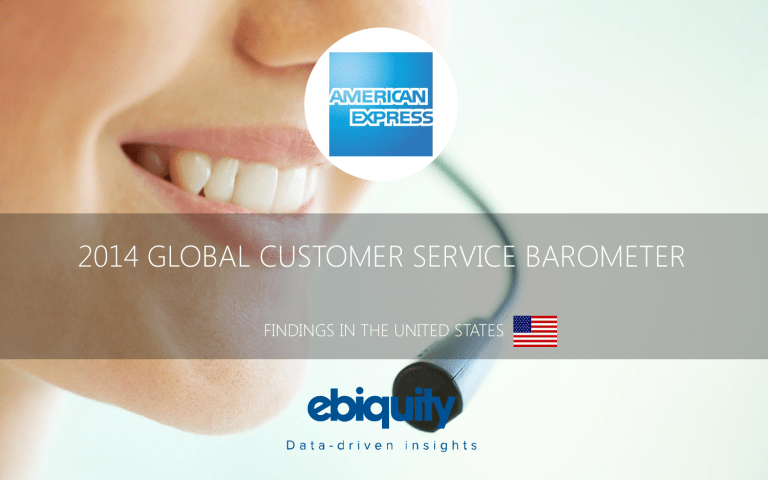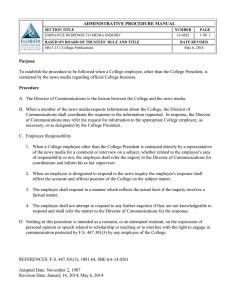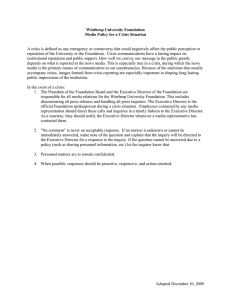2014 global customer service barometer

2014 GLOBAL CUSTOMER SERVICE BAROMETER
FINDINGS IN THE UNITED STATES
Research Methods
This research was completed online among a random sample of consumers aged 18+. A total of 1,000 interviews were completed.
Interviewing was conducted by Ebiquity between August 19 and
September 2, 2014.
The overall results have a margin of error of +/- 3.1 percentage points at the 95% level of confidence.
Companies still meeting consumers’ expectations for customer service experiences
IN GENERAL, WOULD YOU SAY THE CUSTOMER SERVICE
EXPERIENCES YOU HAVE WITH COMPANIES USUALLY…?
Meet your expectations
62%
59%
61%
65%
Just over six in ten (62%) believe that companies meet their customer service expectations (59%, 2012; 61%, 2011).
Miss your expectations
Exceed your expectations
5%
7%
6%
7%
29%
31%
29%
26%
2014
2012
2011
2010
Down from 7% in 2012 and 6% in 2011, only
5% of consumers said that the customer service experiences they have with companies usually ‘exceed their expectations’ and 29% said that companies usually ‘miss their expectations’ for customer service (down from
31% in 2012 and the same as 29% in 2011).
0% 10% 20% 30% 40% 50% 60% 70%
Q. 1
Not Shown: 4% or less Not Sure
More consumers think businesses are paying less attention to providing good customer service
IN THIS CURRENT ECONOMY, DO YOU THINK THAT …?
Businesses pay less attention to providing good customer service
Businesses have increased their focus on providing good customer service
Businesses' attitudes towards customer service have not changed
26%
28%
32%
38%
29%
32%
32%
37%
2014
2012
2011
2010
26%
29%
34%
27%
Although expectations for customer service are being met, nearly two in five consumers believe that, in this current economy, businesses ‘pay less attention to providing good customer service’, a significant increase over the past two years (38% vs. 32% in 2012,
26% in 2011).
The percent of consumers who believe businesses ‘have increased their focus on providing good customer service’ has declined since last year (29% vs. 32% in 2012 and 2011).
0% 5% 10%15%20%25%30%35%40%
Q. 2
Significantly higher/lower than previous year at the 95% confidence level. Not Shown: 8% or less Not Sure
Motivation to pay more attention: consumers will spend more with companies that provide excellent service
Willing to spend more
(overall)
Average additional % willing to spend
Have spent more
HOW MUCH MORE WOULD YOU BE WILLING TO SPEND WITH A COMPANY
THAT YOU BELIEVE PROVIDES EXCELLENT CUSTOMER SERVICE?
14%
13%
13%
9%
68%
66%
70%
58%
2014
2012
2011
2010
5% more
10% more
20% or more
Not willing to spend more
5%
18%
17%
24%
21%
16%
29%
33%
34%
36%
14%
74%
75%
57%
73%
Don’t know
25%
0% 50% 100%
0% 10% 20% 30% 40%
Three out of four (74%) consumers say they have spent more with a company because of a history of positive customer service experiences, similar to the past two years (75% in 2012; 73% in 2011). Over two thirds (68%) of consumers state that they are willing to spend more with a company they believe provides excellent customer service; slightly higher than 2012 (66%) and nearing the seven in ten (70%) reported in 2011. On average they are willing to spend 14% more, slightly more than in the past two years (13% in 2012 and 2011).
Q.6/Q.7 Significantly higher/lower than previous year at the 95% confidence level.
Providing excellent service also helps companies attract new customers
RANK THE FOLLOWING IN TERMS OF WHICH ARE THE MOST IMPORTANT FACTORS WHEN YOU ARE CHOOSING A
COMPANY WITH WHICH TO DO BUSINESS, WHERE 1 = MOST IMPORTANT AND 5 = LEAST IMPORTANT
Rank: 1 2 3 4 5
Good value for the price
Excellent customer service
Better products
20%
18%
51%
25%
29%
24%
25%
24%
13% 7% 5%
19% 11%
19% 10%
Behind providing ‘good value for the price’
(51%), providing ‘excellent customer service’ is the second most important factor consumers consider when choosing a company with which to do business (20%), followed closely by providing ‘better products’ (18%).
Easy to do business online
Convenience
6% 8% 14%
5% 14%
0% 20%
22%
24%
40%
32%
60%
50%
80%
25%
100%
Consumers are least likely to consider ‘ease of doing business online’ (50%, least important) when choosing a company with which to do business.
Q. 11
Delivering on promised value will help companies exceed consumers’ customer service expectations
WHICH ONE OF THE FOLLOWING IS THE BEST WAY THAT A COMPANY CAN STAND
OUT AND EXCEED YOUR EXPECTATIONS FOR CUSTOMER SERVICE?
Deliver to me the promised value at the right price
Make it easy for me to do business with them online and off
Recognize me as an individual who deserves personalized service
22%
21%
29%
The best way that a company can stand out and exceed U.S. consumer expectations for customer service is simple – ‘deliver promised value at the right price’ (29%).
Provide products & services that meet my needs as a customer
Make it easy for me to find information about their products & services
9%
19%
0% 5% 10% 15% 20% 25% 30% 35%
Consumers are also looking for ease in doing business – both online and off (22%). They want personalized service (21%) and products/services that meet their individual needs (19%).
Q. 3
To consumers, excellent service means getting their questions answered by knowledgeable representatives
HOW IMPORTANT ARE EACH OF THE FOLLOWING IN PROVIDING YOU WITH AN
EXCELLENT CUSTOMER SERVICE EXPERIENCE?
Very Important Somewhat Important Not too/Not at all Important
Provide a satisfactory answer to your question
Connnect you with someone who is knowledgeable
Thank you for being a customer
Provide personalized service
Follow up with you on your experience
45%
45%
27%
86%
78%
41%
35%
44%
13% 1%
20%
20%
32%
2%
11%
In order to provide consumers with an excellent customer service experience, representatives must be able to ‘provide a satisfactory answer to their question’ (86%) or be able to ‘connect them with someone who is knowledgeable’ (78%).
Address you by your name
Try to sell you something 8% 7%
0%
21% 35%
85%
44%
20% 40% 60% 80% 100%
However, companies should not overlook providing personalized service (45%) and thanking customers for their business (45%).
Q. 5
Successful customer service representatives are efficient and empowered to handle requests
WHICH ONE OF THE FOLLOWING IS THE MOST IMPORTANT ATTRIBUTE OF A
SUCCESSFUL CUSTOMER SERVICE PROFESSIONAL?
Efficient - Answers my questions or handles my transaction quickly
Empowered - Is able to handle my requests without transfers or escalations
Courteous - Is polite and cordial in addressing me
17%
29%
33%
According to consumers, the most important attribute of a successful customer service professional is ‘efficiency – the ability to answer questions or handle transactions quickly’ (33%).
Human - Connects with me personally, shows empathy
Consultative - Gives me relevant information about my product or experience
7%
14%
0% 5% 10% 15% 20% 25% 30% 35%
Consumers also find it important that a customer service professional is ‘empowered to handle requests without transfers or escalations’ (29%).
Q. 4
Consumers tell more people about their bad customer service experiences than their good experiences
HOW OFTEN DO YOU TELL OTHER PEOPLE ABOUT YOUR
GOOD EXPERIENCE?
HOW OFTEN DO YOU TELL OTHER PEOPLE ABOUT YOUR
POOR EXPERIENCE?
2014
All the time
46%
Sometimes Rarely
47%
Never
6% 1%
Avg # of people they tell
8 2014
All the time
60%
Sometimes Rarely
35%
Never
5%
Avg # of people they tell
21
24
2012 48% 47% 4% 1% 15 2012 56% 37% 5% 1%
2011 48% 46% 4% 2% 9 2011 59% 35% 4% 2% 16
0% 20% 40% 60% 80% 100% 0% 20% 40% 60% 80% 100%
More than nine in ten consumers talk about their good customer service experiences, at least some of the time (93%), while 46% tell someone about them all of the time, similar to the past two years (48% ‘all the time’ in 2012 and 2011).
When it comes to poor customer service experiences, nearly all (95%) consumers talk about them, with 60% reporting that they talk about these experiences all of the time.
On average, consumers tell 8 people about their good experiences (15 in 2012; 9 in 2011), and over twice as many people about their bad experiences (21; 24 in 2012; 16 in 2011).
Q.8/8a/9/9a Significantly higher/lower than previous year at the 95% confidence level.
Consumers make use of various communication channels to talk about customer service experiences
HOW OFTEN DO YOU USE EACH OF THE FOLLOWING CHANNELS OF COMMUNICATION
TO TELL PEOPLE ABOUT YOUR CUSTOMER SERVICE EXPERIENCES?
All the time Sometimes Rarely Never
Face-to-face
Social networking sites (Twitter,
Facebook, etc.)
Text message / SMS
Consumer review websites (Yelp, etc.)
Company website
19%
14%
13%
12%
54%
28%
35%
33%
38%
Online chat / instant messaging 11% 23%
Blog 10% 14%
21%
18%
19%
21%
22%
37%
70%
35%
32%
33%
45%
5% 4%
28%
Most frequently, consumers tell others about their customer service experiences ‘face-toface’ (54%, all the time).
They also make use of ‘company websites’
(50% always/sometimes), text messaging
(49%), social networks and consumer review sites (46%, each).
0% 20% 40% 60% 80% 100%
Q. 10
Positive word-of-mouth is most likely to influence consumers to try a new company
WHICH ONE OF THE FOLLOWING IS MOST LIKELY TO GET YOU TO TRY DOING
BUSINESS WITH A NEW COMPANY?
Recommendations from a friend or family member
A sale or promotion
A company's reputation
An online or social media review
An interesting advertisement
An engaging website
5%
3%
2%
15%
34%
42% Companies should take note that recommendations from friends and family is most likely to get consumers to try doing business with a new company (42%).
Consumers report that positive word-ofmouth is even more important than a sale or promotion (34%).
0% 5% 10% 15% 20% 25% 30% 35% 40% 45%
Q. 12
Poor service can lead to lost sales
IN THE PAST YEAR, HAVE YOU INTENDED TO
CONDUCT A BUSINESS TRANSACTION OR MAKE A
PURCHASE BUT DECIDED NOT TO BASED ON A POOR
CUSTOMER SERVICE EXPERIENCE?
100%
90%
80%
70%
60%
50%
40%
30%
20%
10%
0%
No,
40%
Yes,
60%
No,
45%
Yes,
55%
2014 2012
In the past year, six-in-ten (60%) consumers intended to conduct a business transaction or make a purchase, but decided not to due to a poor service experience – a significant increase from 2012 (55%).
Significantly higher/lower than previous year at the 95% confidence level.
Consumers are generally willing to give companies a chance to make up for a bad service experience
HOW MANY INSTANCES OF POOR CUSTOMER SERVICE ARE YOU WILLING TO EXPERIENCE
FROM A COMPANY BEFORE YOU WILL CONSIDER SWITCHING COMPANIES?
0% 10% 20% 30% 40% 50% 60% 70%
Immediately consider switching after initial poor customer service experience
37%
2 - 3 instances of poor customer service
4 - 5 instances of poor customer service
4%
58%
While most consumers are willing to give a company at least one more chance after receiving poor service before they consider switching, over one-third (37%) immediately consider switching after the initial poor customer service experience.
6 or more instances of poor customer service
1%
Q. 19
Consumers’ preferred channel for customer service inquiries varies depending on the complexity of the inquiry
FOR EACH OF THE FOLLOWING TYPES OF CUSTOMER SERVICE INQUIRIES, WHICH IS YOUR
PREFERRED CHANNEL FOR REACHING OUT TO COMPANIES?
A simple inquiry A more complex inquiry A difficult inquiry
Company website or email
Speaking with a real person on the phone
Telephone automated voice response system
Online chat/instant messaging
Smartphone app*
Face to face
Text message
Social networking site
9% 3% 3%
24%
30%
2014
2012
0% 20% 40% 0% 20% 40% 0% customer service reps face-to-face for any type of inquiry has decreased significantly since 2012.
20% 40%
For simple issues, they prefer going online, but for anything more complicated they want to talk to a real person. The desire to deal with
For simple inquiries, such as locating a product or checking an account balance, over one-third (36%) of consumers prefer using a company website or email. For a more complex inquiry, such as returning a product or getting assistance with a product issue, just under two out of five (37%) consumers prefer speaking with a ‘real’ person on the phone, followed by a ‘face to face’ conversation (19%, down significantly from 24% in 2012), and using a company website or email (17%). For even more difficult or complicated inquiries, almost half of consumers (48%) prefer speaking with a ‘real’ person on the phone, 24% prefer a face to face interaction
(down significantly from 30% in 2012), and only 10% prefer a company website or email.
Q. 13a/b/c Significantly higher/lower than previous year at the 95% confidence level *Note: smartphone app not asked in 2012.
Social media is becoming a more common channel for consumers seeking a customer service response
IN THE PAST YEAR, HAVE YOU UTILIZED SOCIAL MEDIA
TO GET A CUSTOMER SERVICE RESPONSE?
WHICH OF THE FOLLOWING ARE REASONS YOU USE
SOCIAL MEDIA WHEN IT COMES TO CUSTOMER SERVICE?
100%
80%
60%
40%
20%
0%
No, 77%
Yes, 23%
2014
No, 83%
Yes, 17%
2012
Praise a company for a great service experience
Vent frustration with a bad customer service experience
Share information about your service experience with a broader audience
Seek a response from a company to help you with a service issue
Seek rec. from others about great service establishments
Praise an individual for providing a great service experience
Ask questions of other users about how to get better service
53%
48%
50%
46%
46%
47%
40%
36%
35%
35%
33%
34%
43%
50%
2014
2012
0% 20% 40% 60%
Over one in five (23%) consumers say they have utilized social media to get a customer service response, a significant increase from 17% in 2012.
For those who have used social media for customer service, they have done so for a variety of reasons, including
‘praising a company for a great service experience’ (53%) and venting frustration with a bad customer service experience (50%). Compared to 2012, significantly fewer use social media to seek an actual response from a company to help them with a service issue (40% vs. 50% in 2012).
Q.14/Q.15 Significantly higher/lower than previous year at the 95% confidence level Not Shown: 8% or less None of these
Resolution of customer service issues via social media may be hit or miss, but consumers still see improvement
WHEN YOU USE SOCIAL MEDIA TO COMPLAIN ABOUT A
CUSTOMER SERVICE ISSUE, HOW OFTEN DO YOU FEEL YOU GET
AN ANSWER OR YOUR COMPLAINT IS RESOLVED BY THE
COMPANY?
IN THE PAST YEAR, HAVE COMPANIES GENERALLY IMPROVED
OR WORSENED IN TERMS OF HOW QUICKLY YOU FEEL THEY
RESPOND TO YOU OVER SOCIAL MEDIA CHANNELS
SURROUNDING A GENERAL INQUIRY OR COMPLAINT?
50%
40%
30%
20%
10%
0%
21%
31%
44% 45%
22%
17%
13%
6%
2014
2012
70%
60%
50%
40%
30%
20%
10%
0%
55%
60%
37%
33%
8%
7%
Always Sometimes Rarely Never Improved Have not changed Worsened
One in five (21%) consumers who have used social media for customer service inquiries say they always get an answer or have their complaint resolved, significantly lower than 2012 (31%, always). Greater than one-third (35%), however, say they rarely or never get an answer or have their complaint resolved – up from 23% in 2012.
Despite this spotty record, over half of consumers (55%) still feel companies have generally improved their response times over social media channels (down from 60% in 2012).
Q.16/Q.17 Significantly higher/lower than previous year at the 95% confidence level
Consumers are generally patient when it comes to their willingness to wait for customer service
WHEN YOU CONTACT A CUSTOMER SERVICE CENTER BY
PHONE, WHAT IS THE MAXIMUM AMOUNT OF TIME YOU
ARE WILLING TO WAIT ON HOLD?
WHAT IS THE MAXIMUM AMOUNT OF TIME YOU ARE WILLING
TO WAIT FOR HELP FROM CUSTOMER SERVICE IN-PERSON (EX.,
AT A BANK, RETAIL STORE, SERVICE PROVIDER OR RESTAURANT?
Less than 5 min
5 min >10 min
Average
2014 = 13 min
2012 = 13 min
Less than 5 min
5 min >10 min
Average
2014 = 13 min
2012 = 12 min
10 min >15 min 2014
2012
10 min >15 min
15 min >30 min 15 min >30 min
30+ min 30+ min
8%
12%
0% 10% 20% 30% 40% 0% 10% 20% 30% 40%
On average, consumers are willing to wait a maximum of 13 minutes on hold when they contact a customer service center by telephone (unchanged from 2012). Greater than one in five (22%) are willing to wait less than 5 minutes.
In person, consumers are also willing to wait an average of 13 minutes for customer service help (up slightly from 12 minutes in 2012).
Q.20/21
JENNIFER CLARK
T: +1 646 998 7248
F: +1 646 998 7277
E: jennifer.clark@ebiquity.com
EBIQUITY
US Office
156 Fifth Avenue, Suite 604
New York, NY 10010
Disclaimer
This document is confidential to American Express. Disclosure or circulation of this document, or any part of it, may only be made to American Express, its employees who need to have knowledge of this matter and to its nominated agency (if applicable). Unauthorized copying, disclosure or circulation of this document (by any company or individual) represents a breach of copyright and confidentiality. By accepting disclosure of this document you agree to these terms and to indemnify Ebiquity if you breach any of these terms.

